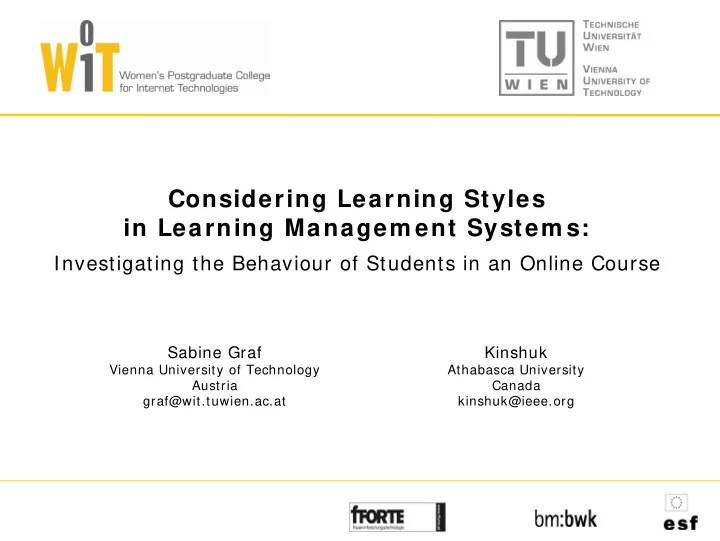

Considering Learning Styles in Learning Managem ent System s: Investigating the Behaviour of Students in an Online Course Sabine Graf Kinshuk Vienna University of Technology Athabasca University Austria Canada graf@wit.tuwien.ac.at kinshuk@ieee.org
Motivation � Learning Management Systems (LMS) are often and successfully used in e-education but provide little or in the most cases no adaptivity � Learners have different needs � Considering learning styles makes learning easier and increases the learning progress � More and more attention is paid on incorporating learning style in web-based education � Adapting courses according to learning styles � Identifying learning styles � Recent work is based on particular systems 2
Research Question Investigating the behaviour of learners in LMS with respect to learning styles 1. Does learners with different learning styles act differently? 2. Can we correlate the learning styles with the behaviour? 3
Felder-Silverman Learning Style Model � Learning styles are described in very much detail � Four dimensions: � Active – Reflective � Sensing – Intuitive � Visual – Verbal � Sequential - Global � Each learner has a preference on each of the four dimensions � Range from + 11 to -11 for each dimension � All assumptions are based on tendencies 4
Patterns of Behavior � Felder and Silverman describe how learners with specific preferences act in traditional learning situations � Patterns are based on FSLSM � Only commonly used features are considered Felder-Silverman Commonly used Learning Style features in LMS Model Patterns of behavior 5
Patterns of Behavior � Content objects � Number of visits and time � Time spent on content objects including graphics � Outlines � Number of visits and time � Self-assessment tests � Number of answered questions � Whether all available tests were performed � Revisions before submission � Time for answering questions � Time for checking results � Result � Results on questions about facts, concepts, details, overview, interpreting solutions, developing solutions, graphics 6
Patterns of Behavior � Exercises � Number of visits and time � Revisions before submission � Results on questions about interpreting and developing solutions � Examples � Number of visits and time � Forum and Chat � Number of visits and time � Number of postings � Navigation � Number of skipping learning objects � Number of jumps to the previous learning object � Number of visits and time spent on course overview page � Number of logins 7
Experiment Design � Laboratory course about Web Engineering at Vienna University of Technology � 43 students participated � Only act/ ref, sen/ int and seq/ glo dimension investigated � ILS questionnaire used for identifying learning styles � 44-item questionnaire � 11 questions for each dimension � Value between + 11 and -11 for each dimension 8
Method: Different Learning Style � Different Behaviour Does students who answer a specific question differently have different behaviour in the LMS? � For each question two groups were generated with respect to the students’ answer � Groups were tested for significant difference for each pattern (t-test and u-test) 9
Results: Different Learning Style � Different Behaviour Active/ Reflective: � � Visits of self-assessment test (+ ) � � Visits of outlines (-) � � Stay at outlines (-) � � Stay at examples (-) � � Questions about interpreting solutions (-) � � Visits of forum (-) ? � Questions about facts (+ ) � Stay at course overview (+ / -) ? 10
Results: Different Learning Style � Different Behaviour Sensing/ Intuitive: � � Visits of examples (+ ) � � Stay at examples (+ ) � � Revisions before submitting (+ ) � � Stay at forum (+ ) � � Post at forum (+ ) � � Visits of content objects (+ ) � � Visits of outlines (+ ) � � Go back to already visited learning material (+ ) ? � Results of questions about overview (-) � Stay at outline (-) ? 11
Results: Different Learning Style � Different Behaviour Sequential/ Global: � � Visits all self-assessment tests (+ ) � � Visits of outline (+ ) � � Stay at outline (+ ) � � Skipping of learning objects (-) � � Visits of course overview (-) � � Revisions before submitting (+ ) � � Stay at the results of self-assessment tests (+ ) � � Posts in the forum (+ ) � � Results of questions about concepts (-) ? � Results of questions about graphics (+ ) 12
Results: Different Learning Style �� Different Behaviour Is there a correlation between the answers and the behaviour? � Point-biserial correlation was performed for each pattern � Most patterns that were significant according to t-test or u-test were also significant according to the point-biserial correlation 13
Conclusion � Several patterns were found showing that different learning styles result in different behaviour � teachers and course developer should be aware of these differences � possible basis for providing adaptivity � Several patterns were found indicating a correlation between learning styles and the behaviour in a course � use this information to identify learning styles from the behavior of students (data-driven approach) 14
Recommend
More recommend